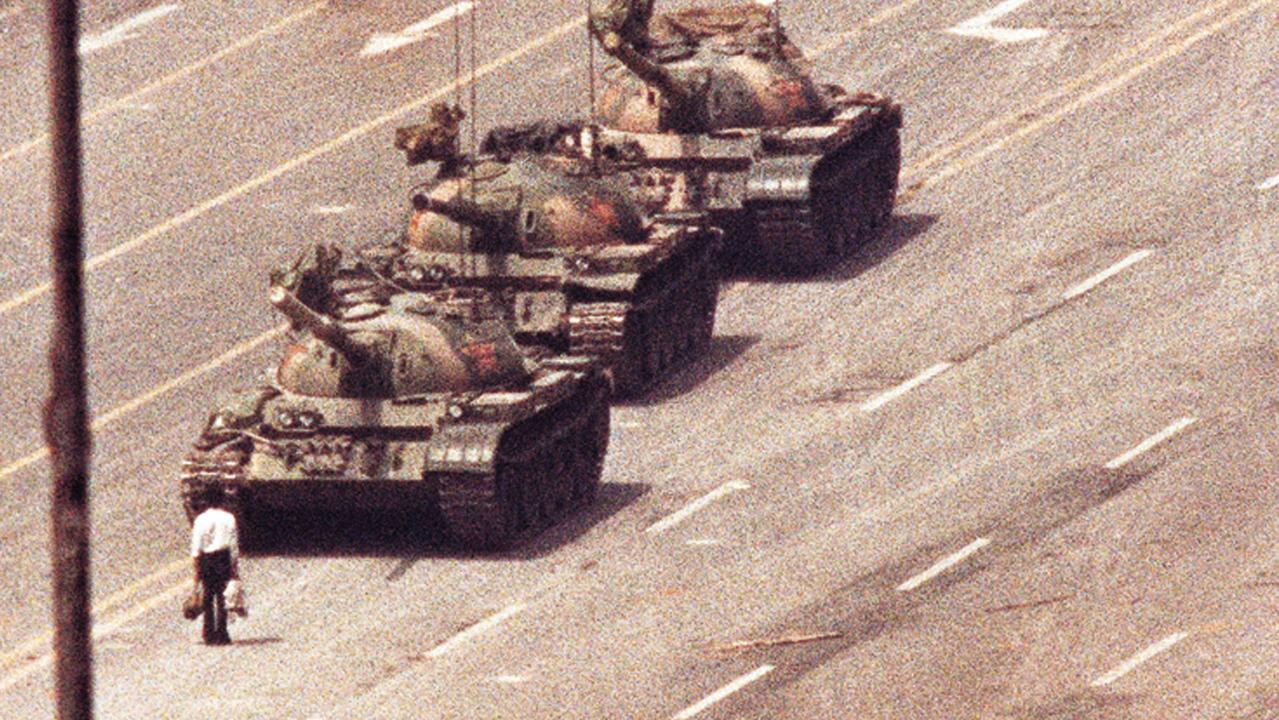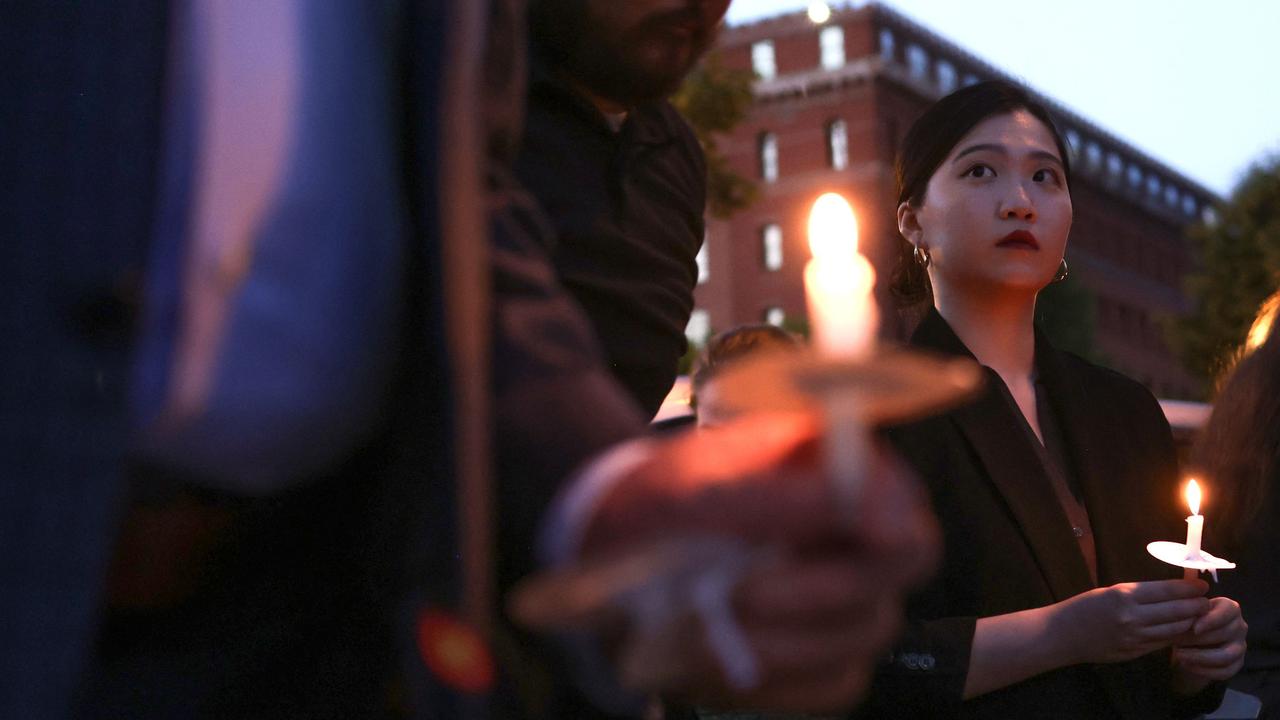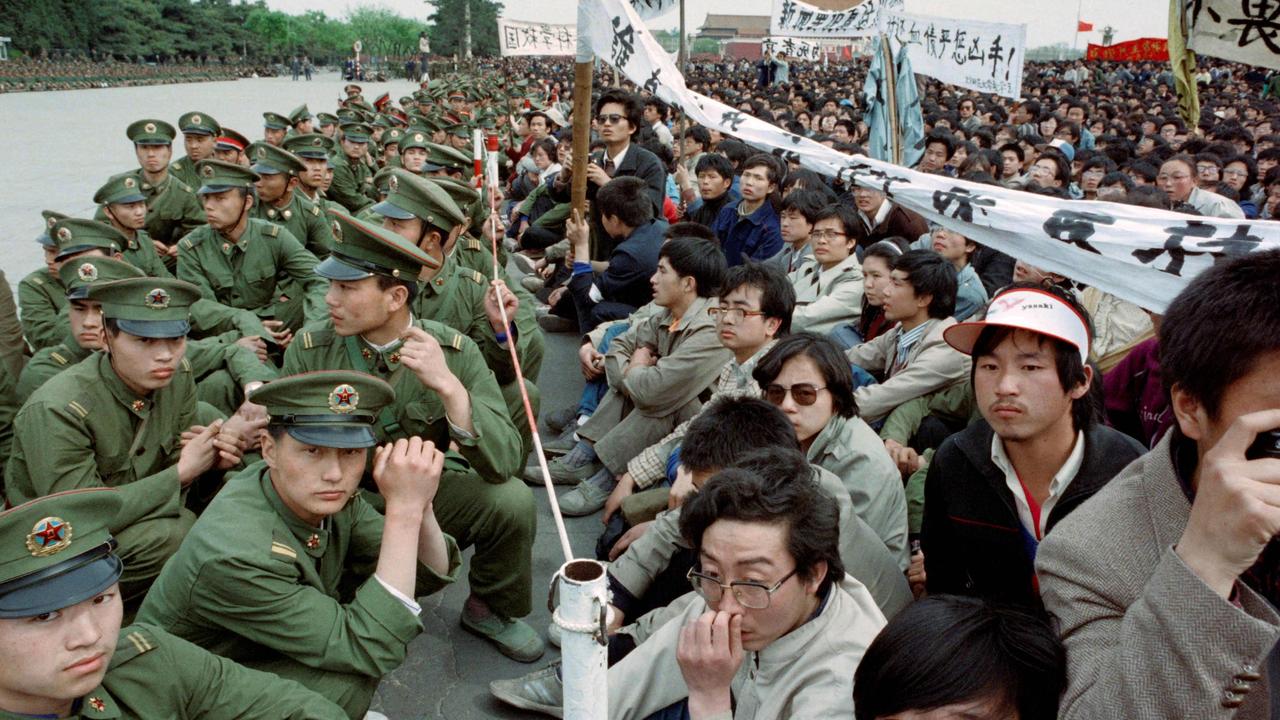‘In his undies’: New details behind iconic pic
‘Tank man’ was one of the most iconic news photos ever taken — but new details have revealed it was very close to never seeing the light of day.

A lone, unidentified man in a white shirt clutching bags stares down a convoy of tanks.
It’s a photograph that has been burned onto the brains of everyone who has laid eyes on it since it was taken exactly 35 years ago today.
It was on this date in 1989 that Chinese troops and tanks forcibly dispersed peaceful protests in Beijing’s Tiananmen Square, brutally quelling huge, weeks-long demonstrations demanding greater political freedoms.
The disturbing level of violence that followed left the world shocked. Decades on, any mention in China of the protests is still met with strict censorship.
Nobody knows how many people died during the brutal crackdown. It’s often said hundreds or possibly over 1000 people were killed at the hands of their own government.
It was among this bloodshed that the lone man came face-to-face with the convoy of tanks — setting the scene for an iconic image that has come to symbolise the everyman’s peaceful struggle against tyranny.
However, the photograph — taken by Jeff Widener, then a photographer for the Associated Press (AP) — nearly never saw the light of day.
It was Monday, June 5, 1989, and Beijing was still in disarray from the crackdown the day before when the photo editor for the AP in Beijing asked Widener to help get photos of Chinese troops from the Beijing Hotel.

The building had the best view of the square which was at that point under government control.
Mr Widener had to conceal his equipment inside his jacket — with a long 400mm lens in one pocket, a doubler in another, film stuffed in his undies and the camera body in his back pocket.
“I’m biking towards the Beijing Hotel and there’s just debris and charred buses on the ground,” he told CNN in a new interview this week. “All of a sudden, there’s four tanks coming, manned by soldiers with heavy machine guns. I’m on my bicycle thinking I can’t believe I’m doing this.”
“I hear rumours that other journalists had had their film and cameras confiscated. I had to figure out a way to get into the hotel,” he added. “I look inside the darkened lobby, and there’s this Western college kid. I walked up to him and whispered, ‘I’m from Associated Press, can you let me up to your room?’ He picked up on it right away and said, ‘Sure.’”
He was talking to an American exchange student who snuck Mr Widener into his sixth-floor hotel room.
In disbelief at what he was seeing, it was there that he took the iconic picture.
He immediately called his picture editor who gave him some very specific instructions — roll up the film, go down to the lobby, and ask one of the many foreign students there to bring it to the AP office.
Mr Widener did just that and sent a student bicycling away with the film hidden in his underwear.
The pictures were then transmitted via telephone lines to the entire globe.

Mr Widener wasn’t the only one to capture the iconic image — known as ‘Tank Man’ — but his shot was the most used. It appeared on the front pages of newspapers all around the world, and it was nominated that year for a Pulitzer Prize.
Arrests made as crackdown continues
As the world remembers the deadly crackdown 35 years ago, China’s mission to censor it from history continues.
On Tuesday, Hong Kong police arrested an eighth person over social media posts about Tiananmen Square.
The arrest was the latest in a series of law enforcement actions taken since last Tuesday against a group that was accused of publishing “seditious” online posts to “take advantage of an upcoming sensitive day”.
The group was the first nabbed under Hong Kong’s “Safeguarding National Security Ordinance”, the city’s second national security law, enacted in March following another security law imposed by Beijing in 2020.
The police said on Monday the eighth person arrested was a 62-year-old man, who was suspected of committing an “offence in connection with seditious intention” — the same offence the first seven were arrested under last week.
It carries a penalty of up to seven years in jail under the new security law. Among those arrested last week was Chow Hang-tung, a prominent activist who led the now-disbanded Hong Kong Alliance that once organised annual vigils to mark the Tiananmen Square crackdown.

Jailed since 2021, Chow is already serving a more than 30-month jail sentence over other charges, including “unauthorised assembly” for her attempt to publicly commemorate the June 4 anniversary.
Hong Kong’s security chief said last week the group made online posts that “were trying to incite disaffection and distrust — and even hatred — against the central government, the Hong Kong government and the judiciary”.
Six of them have been released on bail and subject to a “movement restriction order”, according to the police.
Coded references
Hong Kong used to be the only place under China’s rule where public commemoration of Beijing’s deadly clampdown on pro-democracy demonstrators in Tiananmen Square on June 4, 1989, was allowed.
The three-decade tradition has been banned since 2020, when Beijing imposed the first national security law on the financial hub to quell dissent following huge, and sometimes violent pro-democracy protests the year before.
On Monday night, dozens of police were seen patrolling Hong Kong’s shopping district of Causeway Bay near Victoria Park, the site of annual commemorations before 2020.
A local artist, Sanmu Chen, showed up after 9pm and appeared to trace the Chinese characters for 8964 — which represents the anniversary date — in the air.
As he walked away, police surrounded Chen and took him away in a police van. His lawyer later told AFP that he was released.

Last year, the performance artist was briefly arrested on the eve of the Tiananmen anniversary for chanting “Don’t forget June 4! Hong Kong people, don’t be afraid of them”. He was not charged.
Over the weekend, a Hong Kong Christian weekly newspaper pulled its front-page article about the 35th anniversary, explaining in an editorial that Hong Kong’s society has “become more restrictive”.
A university students’ publication axed its campaign to collect people’s recollections of the crackdown due to “factors we cannot resist”, according to a post on their official social media page on Saturday.
And on Sunday, an independent bookstore said on its Instagram that several police officers were around the premises for an hour, taking down names of customers, after its staff had put “5.35” — a coded reference to June 4 — on its window.
Taiwan president vows to remember Tiananmen
Meanwhile, Taiwan’s new President Lai Ching-te said on Tuesday that the memory Tiananmen Square “will not disappear in the torrent of history”.
Lai’s statement on Tiananmen comes weeks after his inauguration as president, and after China launched military drills around Taiwan, which it claims as part of its territory to be seized one day.
“We will continue to work hard to keep this historical memory alive and touch everyone who cares about Chinese democracy,” Lai said in a Facebook post.
“Because this reminds us that democracy and freedom are not easy to come by, we must... respond to autocracy with freedom, face the expansion of authoritarianism with courage.” Taiwan’s annual vigil is scheduled to take place at 6:40 pm at Taipei’s Chiang Kai-shek memorial hall.
Lai’s Democratic Progressive Party has long defended the sovereignty of Taiwan’s, which has its own government, military and currency.

In his Facebook post Tuesday, Lai said that “a truly respectable country is one where people speak out”.
“Any regime should face up to the voice of the people, especially the young generation, because social change often depends on diverse opinions,” he said.
“In the future, we will continue to unite all forces to deepen democracy in Taiwan, and work with like-minded countries to build a better world.”
Tourists at Tiananmen
The Tiananmen crackdown killed hundreds or people, with some estimating the death toll was higher than a thousand.
Beijing described the events of that night as riots, while those outside the country depict it as a massacre of innocent people, including many students.

Many young people today within China are unaware of the 1989 events due to the wide-reaching censorship.
Asked about the anniversary on Monday, a Chinese foreign ministry spokesperson said the government “has long since reached a clear conclusion with regards to the political turmoil that occurred in the late 1980s”.
At the square in Beijing early on Tuesday morning, tourist groups donning matching neon hats posed for pictures beside the mausoleum of China’s founding leader Mao Zedong.
Security presence was heavy, not unusual at the square, with police posted at every corner, some directing traffic while others observed passers-by through binoculars.
— with AFP




